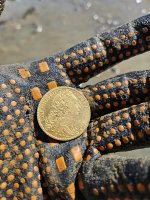Truth
Gold Member
I have a good idea of what it is and this is what I think. I have saved all my weird stuff that I had no idea what it was until I came across this picture and it reminded me of something that I had that looks like it and I searched for two days and found it. That’s why you should always keep your “doodle ma hickeys”.
The first pic is an example the second three pics is the one I have what do you think? Is it from early 1900s
The first pic is an example the second three pics is the one I have what do you think? Is it from early 1900s









